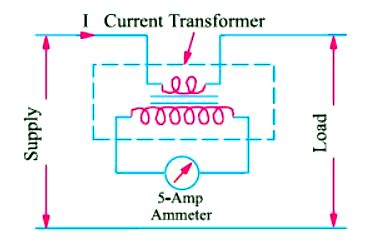Current Transformer
A current transformer takes the place of shunt in d.c. measurements and enables heavy alternating current to be measured with the help of a standard 5-A range a.c. ammeter.
As shown in Figure (A), the current – or series-transformer has a primary winding of one or more turns of thick wire connected in series with the line carrying the current to be measured. The secondary consist of a large number of turns of fine wire and feeds a standard 5-A ammeter (Figure (A)) or the current coil of a watt-meter or watthour-meter (Figure (B)).
For example, a 1,000/5A current transformer with in single turn primary will have 200 secondary turns. Obviously, it steps down the current in the 200 : 1 ratio whereas it steps up the voltage drop across the single-turn primary (an extremely small quantity) in the ratio 1 : 200. Hence if we know the current ratio of the transformer and the reading of the a.c. ammeter, the line current can be calculated.
It is worth noting that ammeter resistance being extremely low, a current transformer operates with its secondary under nearly short-circuit conditions. Should it be necessary to remove the ammeter of the current coils of the wattmeter or a relay, the secondary winding must, first of all, be short-circuited before the instrument is disconnected.

If it is not done then due to the absence of counter ampere-turns of the secondary, the unopposed primary m.m.f. will set up an abnormally high flux in the core which will produce excessive core loss with subsequent heating of and damage of the transformer insulation and a high voltage across the secondary terminals.
AdBlock-2

This is not the case with the ordinary constant-potential transformers because their primary current is determined by the load on their secondary whereas in a current transformer, primary current is determined entirely by the load on the system and not by the load on its own secondary. Hence,
The secondary of a current transformer should never be left open under any circumstances.
Ratio Error of Current Transformer
For obtaining an expression for the ratio error, it will be assumed that the turn ratio n (= secondary turns, N2/primary turns N1) is made equal to the nominal current ratio i.e. n = kn.
In other words, it will be assumed that I1/I2 = n although actually n = I1/I2′ .

![]()
For most instrument transformers, the power factor of the secondary burden is nearly unity so that δ is very small. Hence, very approximately.
![]()
where Iω is the iron-loss or working or wattful component of the exciting current I0
I1 = OA = OB + BC = nI2 cos β + I0 cos [90 − (δ + β + α)] = nI2 cos β + I0 sin (δ + β + α)
Now β = (α + δ) hence I1 = nI2 + I0 sin (α + δ) where n is the turn ratio of the transformer.
![]()
If δ is negligible small, then R ![]()
It is obvious from (i) above that ratio error can be eliminated if secondary turn are reduced by a number.
= I0 sin (α + δ)/I2
Phase angle (β) of Current Transformers
Again from Figure A, we fine that
![]()
Again, if the secondary power factor is nearly unity, then δ is very small, hence

where Iμ is the magnetising component of the exciting current I0.

As found above.

Dependence of ratio error on working component of I0 and that of phase angle on the magnetising component is obvious. If R is to come closer to k and β is to become negligible small, then Iμ and Iω and hence I0 should be very small.
Read article – Ammeter
Visit NCERTplanet.com for NCERT solutions and Textbook downloads




